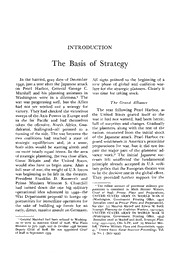
CMH Pub 1-4 Strategic Planning For Coalition Warfare 1943-1944 PDF
Preview CMH Pub 1-4 Strategic Planning For Coalition Warfare 1943-1944
UNITED STATES ARMY IN WORLD WAR [J The War Department STRATEGIC PLANNING FOR COALITION WARFARE 1943-1944 by Mawire Malloff CENTER OF MIL/TAR!' !-I/STOR!' UNITED STA TES A RNIl' WASHINGTON, D.C., 1991 Foreword Within a generation the attitude and policy of the United States toward alliances have undergone a revolutionary reversal. The nation has passed from its traditional suspicion and fear of "entangling alliances" to a policy that heavily stakes its security and interests on the co-operation of other powers. In World War I the U.S. Government cautiously defined its rela- tionship with the powers allied against Germany as that of an Associated Power. In World War II, though last to join the Grand Alliance, it virtu- ally integrated its resources with those of the British Commonwealth and co-ordinated its strategy and war aims with the British and the USSR in the most powerful wartime partnership ever forged. Since 1945 it has emerged as the leader in the North Atlantic Treaty Organization (NATO) and has diligently sought allies and built up alliances all over the troubled world. The climax of its most intensive experience with coalition strategy came in the phase of World War II described in this volume, which should therefore have a special interest for all who are concerned with the impli- cations of the revolution in U.S. foreign policy that has taken place in the twentieth century. R. W. STEPHENS Maj. Gen., U. S. A. Chief of Military History 30 April 1958 Washington, D. C. The Author Dr. Maurice Matloff, graduate of Columbia College, holds M.A. and Ph.D. degrees in History from Harvard University. A member of Phi Beta Kappa and the American Historical Association's Committee on the His- torian and the Federal Government, he has taught History at Brooklyn College and the University of Maryland and has presented papers and lec- tured on military strategy and international affairs before the Army War College, the Navy War College, and the American Historical Association. While in the Army during World War II, he studied the Russian area and language at Yale and served as an instructor in intelligence and as a historian in the AAF. In 1946 he joined the Operations Division historical project in the War Department General Staff as a civilian member, becoming in 1949 the Chief of the Strategic Plans Section, Office of the Chief of Military History. Dr. Matloff is coauthor of Strategic Planning for Coalition War- fare: 1941-1942, and his articles and reviews on modern strategy and state- craft have frequently appeared in various service and professional journals. Preface This volume, like its predecessor, Strategic Planning for Coalition War- fare, 1941-1942, is a contribution to the study of wartime national planning and military strategy. The 1941-42 volume, of which the present author was coauthor, told the story of plans and decisions as they affected the missions and dispositions of the U.S. Army in the defensive phase of coali- tion warfare, when the Grand Alliance was still in its formative stage. The present volume deals with strategic planning in the midwar era from January 1943 through the summer of 1944. This is the story of the hopes, fears, struggles, frustrations, and triumphs of the Army strategic planners coming to grips with the problems of the offensive phase of coali- tion warfare. Basic to this story is the account of planning by General George C. Marshall and his advisers in the great debate on European strategy which followed the Allied landings in North Africa and continued to the penetration of the German frontier in September 1944. During this period the great international conferences from Casablanca in January 1943 to the second Quebec in September 1944 were held and the Allies formulated the grand strategy of military victory. The volume follows the plans, issues, and decisions to the end of the summer of 1944, when the problems of winning the war began to come up against the challenges of victory and peace, and a new era was beginning for the Army Chief of Staff and his advisers. The presentation utilizes both the narrative and the analytical approach. It sets forth the principal steps in the development of the American strategic case, and seeks the raison d'étre behind that case. It attempts to view, through the eyes of the Washington high command, the war as a whole and in its main component parts. The method is to trace the plans, concepts, and ideas of the planners up through the different levels—Army, joint staff (Army and Navy), Joint Chiefs of Staff, the meetings of the American staff with the President, and of the Combined Chiefs of Staff at the plenary sessions with President Franklin D. Roosevelt and Prime Minister Winston S. Churchill. The chronological and structural framework for the study is provided by the big conferences, Casablanca (January 1943), TRIDENT (Washington, May 1943), Quebec (August 1943), Cairo-Tehran (Novem- ber-December 1943), and the second Quebec (September 1944). The pe- riods between the conferences are generally divided into chapters treating the planning for the war against Germany and that against Japan separ- ately and topically. At the conferences themselves, where the Allied
